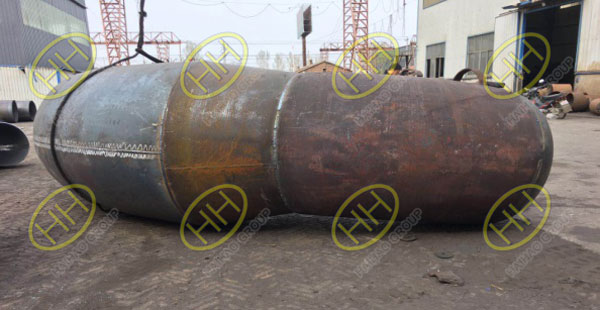What is a pressure vessel?
A pressure vessel is an airtight vessel designed to contain gases or liquids at pressures markedly different from those of the surrounding air.These vessels have a variety of uses in the industrial market and in the private sector.There are inherent dangers in the manufacture and operation of pressure vessels.Therefore, the engineering department has strict regulations on the manufacture of pressure vessels.
Types of Pressure Vessels
Theoretically, pressure vessels can have many different shapes.However, the most common shapes are cylinders, spheres, and cones.The combination of a long cylinder with two caps (heads) is a typical design.Industrial manufacturers usually offer a variety of ASME standard or custom pressure vessels.The most common is carbon steel or stainless steel used in oil/gas and water containers.These pressure vessels are classified as Type I – Type IV.

Large diameter bend wait for hydrostatic pressure test
Pressure Vessel Uses
Most pressure vessels are for industrial use.Some private sector uses include hot water storage tanks and submersible cylinders.Industrial uses for pressure vessels include distillation columns, hydraulic storage tanks and liquefied gas containers.In industry, pressure vessels can be used for high pressure or low pressure vessels, depending on the customer’s needs and the materials used.They can also be used in cooling and heating processes.At the same time, it is also a means to achieve secondary sealing in processing materials.
Either gas or liquid, the pressure vessel can be used in series with the electric immersion heater.Industrial versions of these heaters heat various substances (water, oil, gas, and solvents) by direct contact.Immersion heaters may be mounted on pressure vessels by flanged, welded, or threaded connections.The combination of an electric immersion heater and a pressure vessel is ideal for heating gases and liquids, as well as for generating steam.
Fabrication Process
Most pressure vessels, whether for personal or industrial use, use various types of steel, especially carbon steel and stainless steel.Individual pieces of steel are welded together to make pressure vessels cylinders or spheres.In order to avoid mechanical damage during welding, special precautions should be taken in determining the properties of steel used in forgings.These precautions ensure the mechanical strength of the material and the robustness of the completed pressure vessel.For example, current engineering standards require that only steel with high impact resistance be used in the fabrication of pressure vessels.For some applications of steel pressure vessels, engineering standards also specify the use of special corrosion resistant materials.
Pressure vessels also use partial load-bearing linings and are made of metals, ceramics or polymers.This liner not only helps to carry the load of internal pressure, but also protects the vessel from the effects of the substances contained therein, preventing leakage.The manufacture of pressure vessels must comply with strict manufacturing standards.
The manufacturing code is established by several authorities, including the American Society of Mechanical Engineers, the National Council of Boiler and Pressure Vessel Inspectors, and the European Pressure Equipment Directive.Pressure vessel manufacturers shall follow one or more of these regulations.

